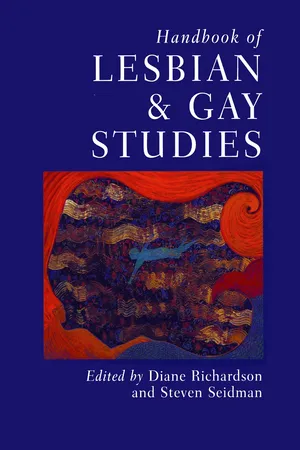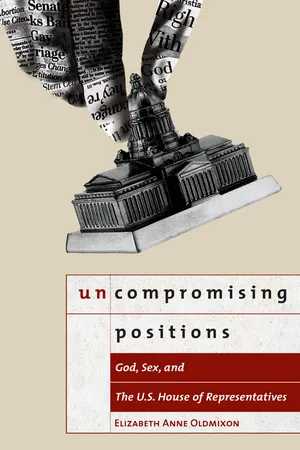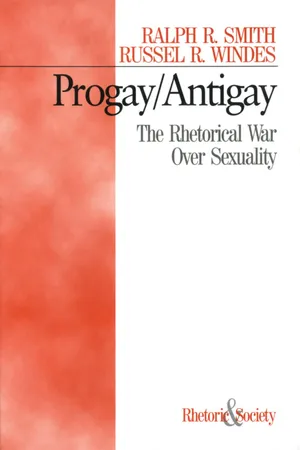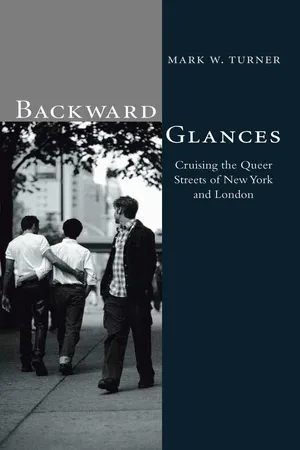History
1920s Gay Culture
The 1920s saw the emergence of a vibrant and underground gay culture in urban centers like New York, Paris, and Berlin. This period marked a time of increased visibility and social acceptance for LGBTQ individuals, with the rise of gay bars, clubs, and artistic communities. However, this cultural flourishing was also accompanied by widespread discrimination and persecution.
Written by Perlego with AI-assistance
Related key terms
1 of 5
6 Key excerpts on "1920s Gay Culture"
- Carol T. Tully(Author)
- 2000(Publication Date)
- Columbia University Press(Publisher)
This era was also marked by World War I and the emergence of the United States as a world power. There was migration from the country-side into cities, and the first gay subcultures began to emerge in urban areas (Bullough and Bullough 1977; Smith and Smith 1980). There were more opportunities for women to live independently of men because of increased educational and economic opportunities, and same-sex unions flourished in both the middle class, where the concept of romantic friend-ships lingered, and the working class, where the idea of “Boston mar-riages” (one woman assuming the role of the man) took root (Faderman 1981). The late 1920s and 1930s saw tremendous social upheaval with the Great Depression and the New Deal. In 1932 there were more than 12 million people unemployed in the country, and this number only signifi-cantly changed by 1939, when there were 10 million unemployed persons (Smith and Smith 1980). Little has been written about the challenges faced by gays and lesbians during this period, but there is evidence that the homosexual subculture did exist during this time and did survive both the depression and the country’s economic recovery with little change in the general belief that homosexual behavior was now an identity and one for which the person needed medical and psychiatric treatment (Altman 1982; Bullough and Bullough 1977). 28 Homosexuality in Historical Perspective Homosexuality in Historical Perspective 29 So, from the turn of the century to the end of the 1930s there was a gradual shift from the idea that homosexuality was a temporary affliction to the generalized belief that it was a lifelong condition that required intervention (D’Emilio and Freedman 1988). These beliefs, while of recent historical derivation, played an important role in how lesbian and gay persons continued to be viewed through the 1940s, 1950s, and 1960s.- eBook - PDF
Queer America
A GLBT History of the 20th Century
- Vicki L. Eaklor(Author)
- 2008(Publication Date)
- Greenwood(Publisher)
Greenwich Village and Times Square also fostered GLBT expression and subcul- tures. The Village famously developed a “bohemian” style noted for radical politics and for opposition to middle-class mores. A group of feminists formed the all-female club Heterodoxy as early as 1912, for example, and their interests ranged widely. For some Village thinkers, radical sexual ideas went hand-in-hand with their politics. Some espoused “free love” for this reason (opposing legal marriage as a tool of government) while others probably just enjoyed it in practice. Same-sex desire and activity were thus more accepted here, though in the climate of experimentation the concept of fixed identities was also questioned; to bohemians one need not be labeled heterosexual, homosexual, or even bisexual. North of the Village in Times Square a highly visible “pansy craze” developed in the twenties. “Pansy” was a term commonly used to describe an effeminate man and he became another kind of entertainment “spectacle” during Prohibition. The craze peaked in 1930–1931, wrote George Chauncey, when “clubs with pansy acts became the hottest in town.” 21 As the economic crisis that began in 1929 deepened (see below) a backlash developed against many “excesses” of the Roaring 20s. Also, when Prohibition ended in 1933 it brought conflicting results: “freedom” to once again open legal bars but now with strict regulation by the state through licensing. In New York, the State Liquor Authority threatened to revoke the licenses of bars that served homosexuals, driving the once-public subculture under- ground and into separate bars controlled by organized crime. Importantly, what this reveals is the myth of a once hidden people slowly and gradually emerging into public view from the 19th to the late 20th century. Instead, the history is more complicated, and includes periods of GLBT visibility so well submerged by the backlashes that only recently, in another era of visibility, do we know of them. - eBook - PDF
- Diane Richardson, Steven Seidman, Diane Richardson, Steven Seidman(Authors)
- 2002(Publication Date)
- SAGE Publications Ltd(Publisher)
Although a formal social movement is lacking during this period, the identities and networks built in gay communities in the early twentieth century would prove to be essential resources for a later movement. Moreover, the distinctive gay cultures that emerged in this period provided men and women with everyday ways to resist hetero-normative gender and sexual codes. Although these turn of the century commu-nities may appear different from current gay communities or movements, it is evident that they constructed positive self-identities, created cultures of resistance, claimed public space, and protected individual men and women who identified with the community. FROM COMMUNITIES TO MOVEMENTS Early same-sex communities of men and women facilitated everyday acts of resis-tance, what Elizabeth Lapovsky Kennedy and Madeline Davis (1993) call ‘prepoliti-cal’ activism. Such resistance eventually led to formal organization. Significantly, the first short-lived social movement organiza-tion in the United States grew out of community institutions. The Society for Human Rights, officially established in Chicago late in 1924, was inspired by the vibrant gay German cultural and political Handbook of Lesbian and Gay Studies 104 scene. Its founder, who had served in Germany as a member of the American armed forces, sought ‘to promote and protect the interests of people who by reasons of mental and physical abnormalities are abused and hindered in the legal pursuit of happiness … guaranteed by the Declaration of Independence’ (cited in Katz, 1976: 385). Compared to gay communities in American cities, gays and lesbians in Berlin in the 1920s were more formally organized. One of the main organizations in Berlin was the Scientific-Humanitarian committee founded by Magnus Hirschfeld. - eBook - PDF
Uncompromising Positions
God, Sex, and the U.S. House of Representatives
- Elizabeth Anne Oldmixon(Author)
- 2005(Publication Date)
- Georgetown University Press(Publisher)
Homosexuality certainly existed in the nineteenth century, and some historians have found evidence of gays and lesbians in American history dating back as far as the sixteenth century (Katz 1976). Pervasive Judeo-Christian values considered homosexuality to be sinful, however, and so did larger American society. “Throughout much of American history gay identity has remained hidden because of an atmosphere of per-vasive hostility to homosexual expression” (Button, Rienzo, and Wald 1997, 23). This hiddenness inhibited the development of a political or cultural gay identity. In the United States, the emergence of industrialization in the nineteenth century facilitated development of a communal or social gay identity. The agrarian lifestyle, with its emphasis on the localized family unit, was giving way to a new lifestyle in which people were more mobile and better able to pursue their indi-vidual pleasures. World War II accelerated the development of a communal gay identity. What was originally called the “homo-phile” movement developed in the wake of World War II because the war disrupted the traditional American social structure. Many people were uprooted from their families and suburban lives and joined the armed forces or the civilian workforce. This trend brought previously isolated gays and lesbians into contact with each other. Rather than return home after the war, many of these newly self-aware gays migrated to major cities such as San Fran-cisco, Boston, and New York. Society at large considered gays perverse and deviant (Rimmerman 2002, 20), but in these major cities gays and lesbians developed their own subculture and sense of community (Button, Rienzo, and Wald 1997, 23–24). In this context, the number of gay bars increased, gay themes emerged in some novels, and Kinsey’s findings on homosexual behavior (Kinsey, Pomeroy, and Martin 1948) were publicized (D’Emilio 2000, 32). - eBook - PDF
Progay/Antigay
The Rhetorical War Over Sexuality
- Ralph R. Smith, Russel R. Windes(Authors)
- 2000(Publication Date)
- SAGE Publications, Inc(Publisher)
Despite its fluidity and the broad range of its cultural practices, the modern lesbian and gay community consists minimally of social networks through which individuals who would not otherwise be in contact with each other can shape and articulate their understanding of themselves as homosexual subjects (Adam, 1987, p. 6). However the gay community and its culture may be construed, the creation of channels for extensive intragroup communication provided the basic condition for the transfor-mation of some gay and lesbian people into political actors and for the or-ganization of collective action (Taylor & Whittier, 1992, p. 104). Sociolo-gist Carl Boggs (1986) asserts that gay political action developed out of 16 PROGAY/ANTIGAY large and active subcultural environments in which individuals could pro-duce collective demands not only for a new kind of personal and com-munity life but for the extension of civil rights to all areas of gay life (p. 44). Such a community, no matter how fragile, provided the affinity groups, free spaces, and prefigurative modes of collective action required by high risk gay/lesbian politics (Gamson, 1992a, p. 62). The appearance of gay and lesbian movements, which made political demands for social change, certainly depended upon the prior creation of gay identity and culture (Cruikshank, 1992, p. 2). While some individuals might personally prefigure organized political resistance, however, movements on behalf of the gay/lesbian community could only begin after a certain critical mass of collective awareness of oppression, and a determination to end it, has been reached (Duberman, 1993, p. 75). Henry Gerber, a Chicago postal worker, founded the Society for Human Rights in the early 1920s. His organizing effort attracted six members and quickly ended in 1925 with his arrest on obscenity charges which were later dismissed (Loughery, 1998, pp. 53-55). - eBook - PDF
Backward Glances
Cruising Queer Streets in New York and London
- Mark W. Turner, Turner, Mark(Authors)
- 2009(Publication Date)
- Reaktion Books(Publisher)
San Francisco. New York. London. These cities had long established and thriving queer cultures and cultures of sexual dissidence, which have become the subject of academic and popular studies seeking to put gay urban history on the map. One of the most recent and celebrated of these is George Chauncey’s Gay New York , an excellent account of the emer-gence of the shifting borders and boundaries of varied and over-lapping gay (male) cultures in New York in the first half of the twentieth century.Other kinds of gay writing, in particular auto-biographies and memoirs, have also helped to establish the experiences of gay lives in the city. But imagining and writing a gay history is not the same thing as imagining and writing a queer history, although the two are often elided and they share some of the same goals, most 44 Backward Glances Cruising Modernity 45 obviously a broadly anti-homophobic politics. John Howard, author of Men Like That , a study of the queer American South, articulates this difference nicely: Queer is a useful rubric. Today it is often deployed ideal-istically, if sometimes problematically, to aggregate varied persons based on their myriad experiences of difference and outsider status – a coalition of the marginalized. I find that queer further opens up interpretive possibilities as we study the past.To speak of a gay history, to consult gay sources, and to query gay individuals often serve to perpetuate gayness as a category. To look for the queer, as variously conceived and embodied, in the past, might well result in richer and more accurate histories of deviancy and normalcy and might help denaturalize their present-day iterations. 2 Queer approaches to understanding the past and present may avoid that levelling out of history I suggested above, may lead us to think outside the grand narratives that continue to see terms such as ‘men’ and ‘women’ in more or less uncomplicated ways.
Index pages curate the most relevant extracts from our library of academic textbooks. They’ve been created using an in-house natural language model (NLM), each adding context and meaning to key research topics.





